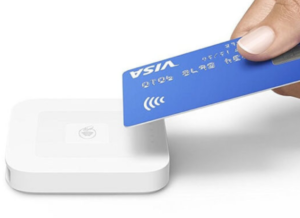Contactless has taken a front seat in the card present payment space in the last few years. As the technology and the framework gains more trust, the security and fraud detection of the ecosystem it lives in grow more robust, and the demands of a new generation of consumers grow, contactless is no longer a bolt on to existing solutions but an important focal point of the transaction. With this comes two separate considerations for merchants and vendors; the ability to unlock contactless payments at the POI and, in my humble opinion, the just as important contactless cardholder experience
A brief intro as contactless comes on the scene
The first idea of contactless payments in the US that, I can remember, were the commercials in the late nineties for the ExxonMobile SpeedPass. It was a little cylindrical fob you put on your key chain and, when you pulled up to the pump, you waved it in front of the pump and away you went pumping your gas.
The technology used for this has very little to do with our modern contactless landscape, but the concept and marketing have stayed the same for most of the last two decades. Contactless is just plain faster, and you are busy, so speed is important. This includes the addition of mobile wallets, just tap and go (you’re probably already have your phone in your hand doom scrolling TikTok anyway).
We all know that a lot has changed in the background in the contactless world, EMV backed specifications, tokenization, host card emulation and many more but the card holder experience has always been promoted the same way. Its faster because its easier, its easier because its faster.
As with most things in our lives the pandemic changes the conversation
Move to 2020 and the talk around contactless has changed drastically. Not much has changed with the cardholder’s experience but the promotion has; “it’s better because you don’t have to touch anything.” Tapping your card or your device, if everything is in sync, means to authorize a transaction you do not have to physically interact with anything but the goods you want to buy and your chosen payment method. However, what we do with those devices both on the merchant and cardholder side has changed dramatically and we should take some time to consider not just what a contactless payment is but what a contactless experience is when architecting or retrofitting solutions, discussing with clients or potential clients, and when considering how our solutions are deployed and how they are able to be managed.
I’ve seen a few stores with signs saying “contactless supported here” which is great for many reasons but at varying times I have walked up to complete my checkout and been presented with “please type phone number here” “please select payment type” “would you like to donate to “X” charity” “how many bags are you using”, after my items have been totaled “would you like to round up for charity” “is the amount correct” and the dreaded “please sign below”.
Are these contactless payments? Yes. Is this a contactless experience? No.
Why is there this disconnect between the concept and the reality? It started with new technology.
Like phones payment terminals are assigned new responsibilities
Payment terminals used to be just that the end point of a cardholder’s journey finalized by the acceptance of their payment. That was what they were designed for and that was their sole mission.
At the beginning terminals had single or double-line monotone displays whose sole purpose was to guide the cardholder through the payment process and inform them of the transaction disposition. With scale, color capacitive LCD touch screens were able to enter the market. Initially just lipstick on the same terminal with the same functionality, creative minds started finding new ways to utilize the additional display real estate and interactive capabilities of these devices. Now, the terminal was no longer there to serve as a conduit for finalizing the payment but to represent multiple aspects of the merchant/cardholder engagement. Inputting loyalty information, donating to the merchant’s preferred charity, even signing up for private label credit cards could now be offloaded from the cashier to the terminal in an attempt to segregate duties. This is the new norm and we all experience it when shopping brick and mortar. Instead of glaring at the cashier while checking out we intently stare at the terminal, waiting for the next question to pop up(the in-lane version of wack-a-mole) so as not to look the fool while the cashier calmly instructs us to select an option to continue.
However, its time to rethink this. Omni-channel shopping is becoming more and more prevalent. Buy online, pay-in-store, phone apps and wallets that allow promotions to be added to your loyalty account and can be tied to a specific card means the shopper, most likely, has already interacted with the merchant in at least one way
As merchants leverage these new touchpoints and as such substantially increase the information they have about their customers, and as shoppers engage with brick and mortar more as pick-up points than anything else their most prevalent experience, and typically the most dreaded, is their last… the transaction. To create a truly contactless experience its time to relegate the terminal back to what it’s good at, accepting payments. Promotions can be applied in wallet, charity donations can come with promotions in app, and auto-BIN resolution can prevent the cardholder from having to select the type of card used. This will increase checkout speed, reduce frustration at checkout, while utilizing more modern methods for merchants to stay engaged with their customers. It’s time to focus not just on the contactless payment but creating a true contactless experience.



